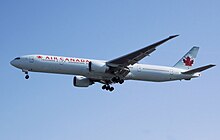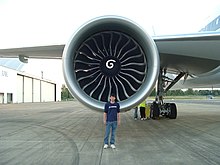General Electric GE90

|
|
| Basic data (GE90-115B) | |
| length | 7289.8 mm |
| diameter | 3429 mm |
| Fan diameter | 3256 mm |
| Dimensions | 8283 kg (18,260 lb ) |
| length | 474 cm |
| Technical specifications | |
| Bypass ratio | 9: 1 |
| Total pressure ratio | 42: 1 |
| Air flow | |
| Power to weight ratio | |
| Max. Thrust reached | 569 kN (127,900 lb f ) |
| Approved thrust | 513 kN (115,300 lb f ) |
| Engine section | stages |
|---|---|
| fan | 1 |
| Low pressure compressor | 4th |
| High pressure compressor | 9 |
| High pressure turbine | 2 |
| Low pressure turbine | 6th |
GE90 is the name for a series of turbofan engines from the US manufacturer GE Aviation , a subsidiary of General Electric . They have a thrust of 329 to 512 kN (74,000 to 115,000 lb f ) and are used exclusively on the Boeing 777 .
The GE90-115B variant , with a fan diameter of 3251.2 mm (128 ") and a thrust of 569 kN (127,900 lb f ) achieved during a load test, is the largest and most powerful jet engine in aviation history.
General

As a further development of the Energy Efficient Engine of NASA 1, which is an industry record: from the 1970s, the ten stages of the high pressure compressor of the GE90 achieve a pressure ratio of the 23rd The new fan blades of the GE90 are made of carbon fiber reinforced plastic , the front edges are clad with titanium to protect against erosion. The curved shape of the blades improves the air flow and thus the economy of the engine.
In order to be able to absorb the torsional stress , a new steel alloy (GE1014) was used, which was machined with extremely low tolerances .
An engine failure resulting in a stopover in the middle of a long-haul route is associated with a lot of effort for airlines if an engine change is necessary: The GE90 series engines have a fan diameter of 3.25 m (128 " ), in the original version it was 3.12 m (123 " ). The diameter of the entire engine (3.43 m) with its fairing is almost as large as the fuselage of the Boeing 737 (3.76 m). This engine can only be transported in an assembled state with oversized cargo aircraft such as the Antonov An-124 or the Boeing 747LCF , which is associated with high costs. With the fan ring dismantled from the high-pressure system, transport with a series freight version of the Boeing 747 is at least possible. On December 17, 2005, a GE90-94B shut down on an Air France flight from Seoul-Incheon to Paris (inflight shutdown), whereupon the machine landed in Irkutsk . In February 2017, a Swiss plane landed in Iqaluit in the north polar region under similar circumstances . In both cases, an Antonov An-124 brought a replacement engine to the stranded aircraft; in the case of Swiss, the failure lasted from landing in the Arctic on February 1 to February 9.
Instead of a possible further increase in thrust, GE Aviation started developing the successor General Electric GE9X . The manufacturer specifies 99,500 lb f as its maximum thrust . For comparison: The largest engine on the Boeing 747-400 generates a thrust of approximately 289 kN (65,000 lb f ).
variants
The GE90 was developed in several versions with different performance data:
| model | Thrust (max. Continuous) |
Admission | Aircraft type | Remarks |
|---|---|---|---|---|
| GE90-75B | February 2, 1995 | Approval expired on July 24, 1995 | ||
| GE90-76B | 335 kN | February 2, 1995 | Boeing 777-200 | |
| GE90-77B | 335 kN | 2nd July 1996 | ||
| GE90-85B | 361 kN | February 2, 1995 | Boeing 777-200 | |
| GE90-90B | 403 kN | 2nd July 1996 | Boeing 777-200 | |
| GE90-92B | 409 kN | 2nd July 1996 | Approval expired on June 26, 2000 | |
| GE90-94B | 403 kN | June 9, 2000 | Boeing 777-200 | |
| GE90-110B1 | 489 kN | July 30, 2003 | Boeing 777-200LR, 777F | The starting thrust is 492 kN |
| GE90-113B | 489 kN | July 30, 2003 | The starting thrust is 505 kN | |
| GE90-115B | 489 kN | July 30, 2003 | Boeing 777-200LR, 777-300ER, 777F | The starting thrust is 514 kN |
Derivatives
- The General Electric GEnx for the Boeing 787 is essentially a further development of the GE90.
- The Engine Alliance GP7200 for the Airbus A380 uses the high pressure system of the GE90. Engine Alliance is a joint venture between GE Aviation and Pratt & Whitney .
Trivia
- A fan shovel of the GE90-115B is on display at the Museum of Modern Art in New York City .
- A milestone was celebrated in 2020, adding up all GE90 engines have a service life of 100 million flight hours. A total of 90 billion kilometers were covered during this time, that is 300 journeys to the sun and back.
Individual evidence
- ↑ Description GE1014 (en) ( Memento of the original from September 22, 2008 in the Internet Archive ) Info: The archive link was inserted automatically and has not yet been checked. Please check the original and archive link according to the instructions and then remove this notice. Warning: lots of advertising!
- ↑ GE Strives to identify Air France engine fault. Flight International , January 3, 2006, accessed December 28, 2015 .
- ↑ This is how expensive the Swiss emergency landing in the Arctic will be , Tages-Anzeiger, February 7, 2017
- ↑ Return from the Arctic , SRF, February 9, 2017
- ↑ GE plans 10% fuel burn improvement for GE9X engine. Flight Global , March 7, 2012, accessed April 20, 2016 .
- ↑ EASA TCDS - data and approval certificate of the GE90 (English) ( Memento of the original from December 28, 2015 in the Internet Archive ) Info: The archive link was inserted automatically and has not yet been checked. Please check the original and archive link according to the instructions and then remove this notice. (PDF; 190 kB)
- ↑ FAA data sheet and approval report for the GE90 models (PDF; 51 kB)
- ↑ The GE90 runs and runs and runs and ... aerotelegraph.com, August 17, 2020, accessed on August 17, 2020 .

